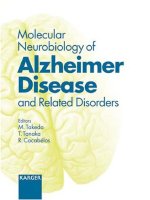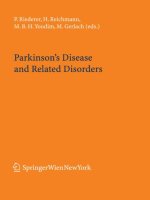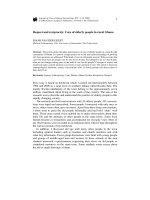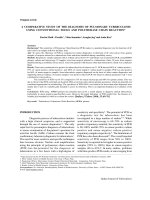Pharmacology and Toxicology of Amphetamine and Related Designer Drugs pot
Bạn đang xem bản rút gọn của tài liệu. Xem và tải ngay bản đầy đủ của tài liệu tại đây (3.35 MB, 377 trang )
Pharmacology
and Toxicology
of Amphetamine
and Related
Designer Drugs
U.S. DEPARTMENT OF HEALTH AND HUMAN SERVICES • Public Health Service • Alcohol Drug Abuse and Mental Health Administration
Pharmacology and Toxicology
of Amphetamine and Related
Designer Drugs
Editors:
Khursheed Asghar, Ph.D.
Division of Preclinical Research
National Institute on Drug Abuse
Errol De Souza, Ph.D.
Addiction Research Center
National Institute on Drug Abuse
NIDA Research Monograph 94
1989
U.S. DEPARTMENT OF HEALTH AND HUMAN SERVICES
Public Health Service
Alcohol, Drug Abuse, and Mental Health Administration
National Institute on Drug Abuse
5600 Fishers Lane
Rockville, MD 20857
For sale by the Superintendent of Documents, U.S. Government Printing Office
Washington, DC 20402
Pharmacology and Toxicology
of Amphetamine and Related
Designer Drugs
ACKNOWLEDGMENT
This monograph is based upon papers and discussion from a technical
review on pharmacology and toxicology of amphetamine and related
designer drugs that took place on August 2 through 4, 1988, in Bethesda,
MD. The review meeting was sponsored by the Biomedical Branch,
Division of Preclinical Research, and the Addiction Research Center,
National Institute on Drug Abuse.
COPYRIGHT STATUS
The National Institute on Drug Abuse has obtained permission from the
copyright holders to reproduce certain previously published material as noted
in the text. Further reproduction of this copyrighted material is permitted
only as part of a reprinting of the entire publication or chapter. For any
other use, the copyright holder’s permission is required. All other matieral
in this volume except quoted passages from copyrighted sources is in the
public domain and may be used or reproduced without permission from the
Institute or the authors. Citation of the source is appreciated.
Opinions expressed in this volume are those of the authors and do not
necessarily reflect the opinions or official policy of the National Institute on
Drug Abuse or any other part of the U.S. Department of Health and Human
Services.
The U.S. Government does not endorse or favor any specific commercial
product or company. Trade, proprietary, or company names appearing in
this publication are used only because they are considered essential in the
context of the studies reported herein.
DHHS publication number (ADM)89-1640
Printed 1989
NIDA Research Monographs are indexed in the Index Medicus. They are
selectively included in the coverage of American Statistics Index,
Biosciences Information Service, Chemical Abstracts, Current Contents,
Psychological Abstracts, and Psychopharmacology Abstracts.
iv
Contents
Page
Preface
ix
Structure-Activity Relationships of MDMA-Like Substances
1
David E. Nichols and Robert Oberlender
Self-Injection in Baboons of Amphetamines and Related
Designer Drugs
30
CA. Sannerud, J.V. Brady, and R.R. Griffiths
Stimulus Properties of Hallucinogenic
phenalkylamines and Related Designer Drugs:
Formulation of Structure-Activity Relationships 43
Richard A. Glennon
Amphetamines: Aggressive and Social Behavior 68
Klaus A. Miczek and Jennifer W. Tidey
Neurochemical Mechanisms Involved in
Behavioral Effects of Amphetamines and Related
Designer Drugs
101
Lisa H. Gold, Mark A. Geyer, and George F. Koob
Neuronal Actions of Amphetamine in the Rat Brain 127
Philip M. Groves, Lawrence J. Ryan, Marco Diana,
Stephen J. Young, and Lisa J. Fisher
v
Page
Methamphetamine and Related Drugs: Toxicity and
Resulting Behavioral Changes in Response to
Pharmacological Probes
Lewis S. Seiden and Mark S. Kleven
146
Role of Dopamine in the Neurotoxicity Induced
by Amphetamines and Related Designer Drugs
James W. Gibb. Donna M. Stone, Michel Johnson,
and Glen R. Hanson
.
161
Acute and Long-Term Neurochemical Effects of
Methylenedioxymethamphetamine in the Rat
179
Christopher J. Schmidt
Effects of MDMA and MDA on Brain Serotonin Neurons:
Evidence from Neurochemical and Autoradiographic Studies
196
Errol B. De Souza and George Battaglia
Characterization of Brain Interactions With
Methylenedioxyamphetamine and
Methylenedioxymethamphetamine 223
Robert Zaczek, Stephen Hurt, Steven Culp, and
Errol B. De Souza
Pharmacologic profile of Amphetamine Derivatives at
Various Brain Recognition Sites: Selective Effects
on Serotonergic Systems
George Battaglia and Errol B. De Souza
240
Effects of Amphetamine Analogs on Central Nervous
System Neuropeptide Systems
Glen R. Hanson, Patricia Sonsalla, Anita Letter,
Kalpana M. Merchant, Michel Johnson, Lloyd Bush,
and James W. Gibb
Effects of Neurotoxic Amphetamines on Serotonergic
Neurons: Immunocytochemical Studies
Mark E. Molliver, Laura A. Mamounas, and
Mary Ann Wilson
Studies of MDMA-Induced Neurotoxicity in Nonhuman
Primates: A Basis for Evaluating Long-Term Effects
in Humans
George A. Ricaurte
259
270
306
vi
Page
Dose- and Time-Dependent Effects of Stimulants
323
Everett H. Ellinwood, Jr., and Tong H. Lee
Recommendations for Future Research on Amphetamines
and Related Designer Drugs
341
Ray W. Fuller
List of NIDA Research Monographs
358
vii
Preface
The abuse of amphetamines is of national concern from a public health
perspective. Review of this subject is timely and important, because the
problem of amphetamine-like drugs has recently been amplified by the
introduction of designer drugs in the illicit market. There has been an
increasing number of attempts by chemists in clandestine laboratories to
synthesize structurally altered congeners that might intensify the mood-
altering property of this class of compounds.
While attention over the last
few decades has been centered on research related to amphetamine,
methamphetamine, and clinically prescribed amphetamine derivatives
including fenfluramine, recent attention has focused on a variety of
amphetamine-related designer drugs. These designer drugs include ring-
substituted derivatives of amphetamine and methamphetamine such as
3,4-methylenedioxyamphetamine (MDA) and 3,4-methylenedioxymetham-
phetamine (MDMA “ecstasy”), respectively. MDMA has been the focus of
a great deal of recent attention, since it represents one of a number of
“designer drugs” that is being increasingly abused among certain segments
of the population, especially among college students. This popularity is
ascribed to the drugs’ mixed central nervous system (CNS) stimulant and
hallucinogenic effects. Furthermore, MDMA has been the subject of recent
scientific and legal debate, as several psychiatrists have reported that
MDMA may “enhance emotions” and “feelings of empathy” and thus serve
as an adjunct in psychotherapy. While the psychotherapeutic usefulness of
this drug remains to be determined, a great deal of research has been
carried out on the abuse liability, behavioral effects, and neurotoxic effects
of the amphetamine-related designer drugs.
A technical review meeting entitled “Pharmacology and Toxicology of
Amphetamine and Related Designer Drugs” was held at the National
Institutes of Health on August 2-4, 1988. The purpose of the technical
review was to bring together scientists who have been carrying out research
in the area to (1) summarize the research findings, (2) understand the
neuronal mechanisms through which the amphetamines produce their effects,
and (3) develop a consensus regarding future directions that may lead to
better characterization of the effects of these drugs on various physiological
parameters. An understanding of the mechanisms is critical to the
development of therapeutic approaches for the treatment of intoxication,
addiction, and adverse effects. The proceedings of this meeting are
presented in the following chapters.
ix
Khursheed Asghar, Ph.D.
Division of Preclinical Research
National Institute on Drug Abuse
Rockville, MD
Errol B. De Souza, Ph.D.
Neurobiology Laboratory
Neurosciences Branch
Addiction Research Center
National Institute on Drug Abuse
Baltimore, MD
x
Structure-Activity Relationships of
MDMA-Like Substances
David E. Nichols and Robert Oberlender
INTRODUCTION
There is virtually no one who is involved in drug abuse research, or who
studies the properties of recreationally used drugs, that is not by now fami-
liar with 3,4-methylenedioxymethamphetamine (MDMA) (figure 1). Over
the past 4 years this substance, usually referred to in the popular press as
“Ecstasy,” has received widespread media attention, This chapter will relate
recent fmdings with respect to the potential dangers attendant on the use of
MDMA and explore its pharmacological properties.
MDMA (1)
FIGURE 1. MDMA
As the title implies, MDMA has pharmacological properties that set it apart
from other classes of drugs. This is one of the most intriguing aspects of
MDMA, largely overlooked as researchers examined the potential risks to
health of MDMA use. Basic questions of how drugs work and why some
are pleasurable and some are not are fundamental to our understanding of
why humans use drugs. Although much of the popularity of MDMA can
no doubt be attributed to curiosity following media attention, the drug itself
must have some rewarding qualities.
MDMA typifies a central problem with the substituted amphetamine-type
substances: The fact that we know so little about any of these kinds of
drugs. What does MDMA actually do? What are the psychopharmacologi-
cal properties that make it attractive for recreational use? Is it “just another
hallucinogenic amphetamine,” as some have asserted? In the following
1
discussion, an attempt will be made to address some of these issues, and to
put the questions into a broader perspective.
MDMA was patented in 1914 by a German pharmaceutical firm and evalu-
ated as an appetite suppressant (Shulgin 1986). In that sense, MDMA is
not a “designer drug.” Its rediscovery in the late 1970s probably had little
to do with the fact that it was, technically speaking, a legal drug. There
were a variety of legal psychoactive drugs, many of which could probably
have been synthesized and marketed with greater economic profit than
MDMA, a substance with unremarkable quantitative potency, being only two
to three times more active on a weight basis than mescaline (Shulgin and
Nichols 1978). Nonetheless, no other substituted amphetamines with the
popularity of MDMA have appeared. The explanation seems to be that
MDMA has psychopharmacological properties that are deemed especially
rewarding to the user.
MDMA is believed to have unique psychoactive properties that clearly
distinguish it from hallucinogenic or psychostimulant phenethylamines. Not
only have MDMA users consistently reported this distinctiveness, but
subsequent studies of MDMA and similar compounds, in many laboratories.
have shown that they do not fit within the structure-activity relationships
that presently are understood to define the hallucinogenic amphetamines.
STRUCTURAL FEATURES OF MDMA
One of the structural features of MDMA that is somewhat unusual is the
fact that it is 3,4-disubstituted. Both 3,4-methylenedioxyamphetamine
(MDA) (figure 2) and MDMA possess the 3,4-methylenedioxy function, and
there apparently are no other active compounds known that fall within the
MDA (2)
FIGURE 2. MDA
substituted amphetamine class and have substituents only in the 3 and 4
positions. The largest group of substituted amphetamines with significant
haIlucinogenic potency possess either 3,4,5- or 2,4,5- trisubstitution patterns.
The parent compound MDA, although classified as a hallucinogenic amphe-
tamine and available on the illicit market for about 20 years, had gained a
reputation as the “love drug” (Weil 1976). It had been recognized for many
years by both recreational drug users and clinicians (Turek et al. 1974) that
2
MDA had unique psychoactive properties that were different from hallu-
cinogens such as LSD or mescaline. While MDA in high doses appears to
be hallucinogenic or psychotomimetic, it seems not to have been used for
this effect, but rather for its effects on mood: production of a sense of
decreased anxiety and enhanced self-awareness. Even early reports
described the desire of MDA users to be with and talk to other people
(Jackson and Reed 1970). MDA is also the only substituted amphetamine
that received serious clinical study as an adjunct to psychotherapy (Yensen
et al. 1976).
A second structural feature of MDMA that distinguishes it from hallucino-
genic amphetamines is the fact that it is a secondary amine. That is, the
basic nitrogen is substituted with an N-methyl, while hallucinogenic
amphetamines are most potent as primary amines. In either 3,4,5- or
2,4,5-substituted phenethylamine derivatives, N-methylation decreases
hallucinogenic potency by up to an order of magnitude (Shulgin 1978).
When MDA is ingested, the hallucinogenic effects are long lasting, typically
10 to 12 hours, similar to the duration of LSD or mescaline. By contrast,
MDMA has a much shorter action, with perhaps a 3- to 5-hour duration of
effects. There is no evidence that typical doses of MDMA lead to hallu-
cinogenic effects in a significant proportion of users, although in high doses
hallucinogenic effects have been reported (Siegel 1986). Thus, the simple
addition of the N-methyl group limits the temporal course of the action to
less than half that of MDA and attenuates or abolishes the hallucinogenic
effects that occur with MDA itself.
A third important difference between MDMA and the hallucinogenic
amphetamines is the reversal of stereochemistry that occurs in MDMA. In
every substituted hallucinogenic amphetamine that has been studied, the
isomer with the R absolute configuration in the side chain is more potent in
animal models, in a variety of in vim assays, and in man (figure 3). The
two isomers differ in potency by a factor of 3 to 10, depending on the
assay system (Nichols and Glennon 1984). By contrast, the S isomer of
MDMA is more potent (figure 4). This was first reported in experiments
with rabbits and in clinical studies (Anderson et al. 1978), and it has
recently been confirmed in other animal models (Oberlender and Nichols
1988; Schechter 1987).
It is difficult to trivialize the significance of this argument, since the
stereospecificity of biological receptors is accepted as a basic tenet of
pharmacology. There is no rationale or experimental precedent for believing
that the 3,4-methylenedioxy substitution should do anything that would
cause the receptor(s) involved to accommodate a side chain stereochemistry
reversed from that for phenylisopropylamines with other aromatic
subtituents.
3
FIGURE 3. The more active R-(-)-enantiomer of the hallucinogenic
amphetamine DOM
S-(+)-MDMA
FIGURE 4. The more active S-(+)-enantiomer of MDMA
Several studies have now clearly shown that the R enantiomer of MDA has
the hallucinogenic effects of the racemate, while the S enantiomer possesses
more potent MDMA-like properties than the R in animals models (Anderson
et al. 1978; Shulgin 1978; Glennon and Young 1984a; Nichols et al. 1982;
Nichols et al. 1986; Oberlender and Nichols 1988). Further, although
(+)-MDA appears similar to amphetamine in the drug discrimination assay
in rats (Glennon and Young 1984a), it is not generally realized that the
effects of (+)-MDA in humans qualitatively resemble those of MDMA,
rather than those of amphetamine (Shulgin, personal communication, 1985).
This is a unique situation. Both enantiomers of MDA are active, having
nearly equal quantitative potencies, but differing in qualitative effect.
N-methylation of the racemic material dramatically and selectively attenuates
the hallucinogenic effects of the R enantiomer, while essentially leaving
intact the properties of the S enantiomer.
In earlier proposals (Anderson et al. 1978), based on this stereoselectivity
for the S enantiomer of MDMA, it was suggested that, rather than having a
direct effect at serotonin receptors, perhaps MDMA was a neurotransmitter-
releasing agent, acting in a fashion similar to amphetamine, for which the S
enantiomer is also more active than the R enantiomer. A subsequent study
4
in our laboratory indicated that the S isomers of MDA and MDMA were
indeed potent releasers of [³H]serotonin from prelabeled rat brain
synaptosomes (Nichols et al. 1982). Recently, it was repotted that MDA
and MDMA were potent releasers of serotonin from superfused hippocampal
slices prelabeled with [³H]serotonin (Johnson et al. 1986). In all studies to
date, whether of release of monoamines from synaptosomes or brain slices,
or of the inhibiting of monoamine reuptake into synaptosomes (Steele
et al. 1987), the S enantiomer of MDMA is either equipotent to the R
isomer or more potent.
THE ENTACTOGENS
As a consequence of these and other studies that have indicated that
MDMA has a pharmacology different from the hallucinogenic amphet-
amines, and in view of the reports by certain psychiatrists (Greer and
Tolbert 1986; Wolfson 1986) that MDMA could facilitate the process of
psychotherapy, it was hypothesized that MDMA and related compounds
represent a new pharmacological class, with as yet unexplored potential as
psychiatric drugs (Nichols 1986; Nichols et al. 1986). This class of drugs
has been called entactogens. Recently, efforts have been directed toward
understanding the mechanism of action of MDMA and related compounds
and testing the hypothesis that entactogens are a novel pharmacological
class, distinct both from hallucinogenic agents and from central stimulants
such as amphetamine or cocaine.
Important support for this hypothesis came from the discovery that the
alpha-ethyl homolog of MDMA, MBDB (figure 5) possessed MDMA-like
S-(+)-MBDB (3)
FIGURE 5.
The S-(+)-enantiomer of the alpha-ethyl homologue of MDMA,
MBDB
properties in man and in the drug-discrimination paradigm in rats (Nichols
et al. 1986; Oberlender and Nichols 1988). It was known that homologa-
tion of the alpha-methyl of the hallucinogenic amphetamines completely
abolished hallucinogenic activity (Standridge et al. 1976). For example, the
alpha-ethyl homolog of R-DOM, BL-3912A (figure 6) was evaluated by a
major pharmaceutical firm and found to lack hallucinogenic activity at doses
more than a hundredfold higher than those effective for DOM (Winter
1980). This additional feature of the entactogens, that the alpha-ethyl
5
homologs retained activity, was a final and most powerful argument that
MDMA, and certainly MBDB, could not lit within the well-established
structure-activity relationships of the hallucinogenic amphetamines.
R-(-)-BL3912A (4)
FIGURE 6. The nonhallucinogenic alpha-ethyl homologue of DOM,
BL-3912A
STUDIES OF STRUCTURE-ACTIVITY RELATIONSHIPS
EEG Studies
Recently, Dr. W. Dimpfel has used quantitative radioelectroencephalography
in the rat to characterize the electroencephalograph (BEG) “fingerprint” of
hallucinogenic amphetamines, MDMA, and MBDB. In this technique, four
bipolar stainless steel electrodes are chronically implanted in each of four
brain regions in rats: the frontal cortex, the hippocampus, the striatum, and
the reticular formation (Dimpfel et al. 1986). The rats are freely moving;
transmission of field potentials is accomplished using a telemetric device.
The EEG is analyzed by Fourier analysis; power density spectra are
computed for periods of 4 seconds, segmented into six frequency bands, and
averaged on each channel over timeblocks of 15 minutes.
Using this method, a variety of hallucinogenic and nonhallucinogenic com-
pounds were examined. As previously reported (Spüler and Nichols 1988),
hallucinogens produce a marked increase of power in the a, frequency
(7.0 to 9.50 Hz) in the striatum. The ability to increase power in this
region of the EEG has been observed for other classes of serotoninergic
drugs, including the 5-HT
1A
agonists ipsapirone, gepirone, and buspirone,
and with serotonin-uptake inhibitors (Dimpfel et al. 1988). With 5-HT
1A
agonists, however, an increase in power is recorded only from the frontal
cortex and hippocampus.
Doses of DOM, DOB, or DOI of 0.2, 0.1, and 0.1 mg/kg, respectively,
produced a pronounced and long-lasting increase in a, power recorded from
the striatum. By contrast, doses of (+)-MDMA and (+)-MBDB up to
1.6 mg/kg did not elicit this characteristic feature in the EEG. Thus, in this
6
sensitive quantitative EEG procedure, neither MDMA nor MBDB elicited an
EEG fingerprint (four electrodes by six frequency bands per electrode) that
resembled that produced by the hallucinogenic amphetamines DOM, DOB,
DOI, or LSD. These data are consistent with the results obtained in other
models and further support the hypothesis that MDMA and MBDB are not
hallucinogenic phenethylamines.
Thus, for this class of psychoactive agent, preliminary structure-activity
relationships are being formulated. Currently, four structural features
contrast the structure-activity relationships of entactogens with those of
hallucinogenic amphetamines.
(1)
(2)
(3)
(4)
Ring substitution at only the 3,4- positions does not give active
hallucinogens, except for MDA. However, this substitution is active
for entactogenic agents.
N-methylation greatly attenuates hallucinogenic activity, but has no
significant effect on potency of entactogens. N-ethylation also seems
to allow compounds to retain entactogenic activity.
The more active stereochemistry of the entactogens is S, while that of
the hallucinogenic amphetamines is R.
Extension of the alpha-methyl to an alpha-ethyl abolishes
hallucinogenic activity, but has only a minor effect on entactogens.
Drug Discrimination Studies
At the present time these contrasts seem sufficient to distinguish between
the two drug classes. The stereochemical argument and the effects of
alpha-ethylation are extremely powerful. A significant problem with the
hypothesis remained: showing that entactogens differed from another struc-
turally related class, the central nervous system (CNS) stimulants. Several
studies have characterized MDMA as an amphetamine-like or cocaine-like
agent, based on its stimulus properties or its self-administration in primates
(Beardsley et al. 1986; Lamb and Griffiths 1987; Evans and Johanson 1986;
Kamien et al. 1986). It is well known that both amphetamine and cocaine
have powerful effects on dopamine pathways in the brain, and it seems
likely that drugs that release dopamine, or stimulate dopamine receptors,
have reinforcing properties that lead to self-administration and dependence
liability (Wise and Bozarth 1987).
It could not be anticipated that the extension of the alpha-methyl of MDMA
to an alpha-ethyl would also attenuate the effects of the compound on
dopaminergic pathways in the brain. In contrast to MDMA, MBDB has no
significant effect either on inhibition of uptake of dopamine into striatal
synaptosomes (Steele et al. 1987) or on release of dopamine from caudate
7
slices (Johnson et al. 1986). In subsequent drug discrimination experiments
in rats, the dopaminergic properties of MDMA were evident, while MBDB
seemed to have a pharmacologically “cleaner” discriminative cue.
To characterize further the behavioral pharmacology of MDMA and MBDB,
extensive drug discrimination studies were carried out using rats trained to
discriminate saline from LSD, saline from (+)-amphetamine, saline from
(±)-MDMA, and saline from (+)-MBDB. Table 1 summarizes the results of
those experiments. As is the case with hallucinogens, the drug discrimina-
tion paradigm should not be considered, in strict terms, an animal model for
entactogen activity. Yet, data from these experiments can provide a good
initial behavioral evaluation of the qualitative and quantitative effects of a
variety of compounds of interest.
It is clear from these results that, in MDMA- or MBDB-trained rats, com-
plete generalization of the training cue to the typical hallucinogenic drugs
LSD, DOM, and mescaline does not occur. Furthermore, transfer of the
training stimulus does not occur to MDMA or MBDB in animals trained to
discriminate LSD from saline (Nichols et al. 1986). Although MDMA has
been shown to substitute for mescaline (Callahan and Appel 1987).
(+)-MBDB-trained rats did not recognize the mescaline cue as similar to the
training drug. These results are consistent with the conclusion that MDMA
and MBDB are not hallucinogenic, as discussed earlier.
These data clearly illustrate the enantioselectivity of the (+)-isomers of
MDA, MDMA, and MBDB in producing an MDMA-like stimulus and
underscore the fact that in vitro studies of the biochemical pharmacology of
these substances should reveal similar selectivity, once the primary
pharmacological process underlying the interoceptive cue is identified. The
data also indicate that (+)-MDA is the most potent of all the drugs tested in
MDMA- or in (+)-MBDB-trained animals. The fact that (+)-MDA does not
substitute in amphetamine-trained animals in our studies supports the
argument that the pharmacology of this enantiomer of MDA is MDMA-like
and is not like amphetamine.
Although amphetamine substitutes for MDMA in our studies, this occurs
only at doses that disrupt a significant number of animals. Furthermore, the
large ED
50
for amphetamine substitution in MDMA-trained rats is certainly
not consistent with the known potency of amphetamine in measures of its
stimulant activity. That is, in man, or in animal assays of its activity as a
CNS stimulant, amphetamine is perhaps 10 times more potent than MDA or
MDMA. Thus, its large ED
50
relative to that of the enantiomers of MDA
or MDMA seems to suggest strongly that the primary discriminative cue of
MDMA cannot simply be “amphetamine-like.” Although some investigators
have reported stimulus transfer with MDMA in animals trained to discrimi-
nate amphetamine from saline, in our paradigm no substitution occurred.
8
TABLE 1.
Results of drug discrimination transfer tests in LSD, (+)-am-
phetamine, (±)-MDMA, or (+)-MBDB-trained rats (ED
50
expressed in micromoles per kilogram of body weight)
Substitution
Drug
LSD
LSD
0.025
AMP
Training Drug
MDMA
NS
PS
1
(+)-MBDB
PS
2
DOM
0.61
NS
NS
NS
(+)-AMP
NS
1.68
4.22
NS
(+)-MDA
NS NS
1.63 1.43
(-)-MDA
2.94
NS
2.27 3.09
(+)-MDMA
NS NS
1.92 1.67
(-)-MDMA
NS NS 5.03 3.09
(+)-MBDB NS
NS
3.67 3.28
(-)-MBDB NS
NS
6.71
6.51
Cocaine
NT 20.0
13.9 PS
3
Mescaline
33
Fenfluramine
PS
4
NS
b
NT
NS
NS
NT
2.01
KEY:
NS=no substitution occurred; PS=partial substitution; NT=not tested.
NOTE:
Training doses: LSD tartrale 0.186 µmol/kg; (+)-amphetamine sulfate
5.43 µmol/kg; racemic MDMA.HCl 7.63 µmol/kg; and (+)-MBDB.HCI 7.19 µmol/kg.
1
78% at 0.372 µmol/kg;
2
57% at 0.186 µmol/kg;
3
63% at 29.42 µmol/kg; and
4
7l% at
4.68 µmol/kg.
SOURCES: Stolerman and D’Mello 1981; Schechler and Rosecrans 1973.
Differences in experimental design or in numbers of animals and doses
tested may account for this discrepancy. In our experiments, symmetrical
transfer did not occur between MDMA and amphetamine.
These results show that the MDMA cue is complex and may have some
similarity to amphetamine. However, suggestions that the pharmacology of
(+)-MDMA is essentially the same as that of amphetamine are clearly not
warranted by the data, This partial amphetamine-like action is believed to
9
be reflective of the effect that MDMA has on dopaminergic pathways
(Johnson et al. 1986; Steele et al. 1987). Other workers have reached
similar conclusions (Gold and Koob 1988).
Similarly, self-administration of MDMA in monkeys trained to self-
administer amphetamine (Kamien et al. 1986) or in monkeys or baboons
trained to self-administer cocaine (Beardsley et al. 1986; Lamb and Griffiths
1987) probably reflects a dopaminergic component to the pharmacology of
MDMA. This would be consistent with current theories of dopamine
involvement in the mechanism of action of drugs with dependence liability
(Wise and Bozarth 1987).
In vitro studies have also shown that the alpha-ethyl congener MBDB lacks
significant effects on dopamine systems in the brain. The drug discrimina-
tion data support this idea, and amphetamine does not substitute in
(+)-MBDB-trained rats. Furthermore, while cocaine fully substitutes in
MDMA-trained rats. it produces partial substitution in (+)-MBDB-trained
rats. This is further evidence of the decreased effect of MBDB on
catecholaminergic systems. If the data have been interpreted correctly, this
might suggest that MBDB would not be self-administered in animal models
of dependence behavior, and, hence, might have low abuse potential. It has
been found, however, that (+)-MBDB produces serotonin neurotoxicity in
rats, although MBDB is somewhat less toxic than MDMA (Johnson and
Nichols, unpublished).
To summarize the data in table 1, neither MDMA nor MBDB has hallu-
cinogen-like discriminative stimulus properties. Symmetrical transfer of the
MDMA and MBDB stimulus indicates that their primary discriminative
stimulus effects are very similar. For both MDMA and MBDB, there is
enantioselectivity for the S isomer, with about a twofold eudismic ratio.
Finally, the substitution of (+)-amphetamine and cocaine in MDMA-trained
rats may indicate that MDMA has some psychostimulant-like properties,
while MBDB seems to lack this activity.
Effect of the Side Chain Alpha-Ethyl
It seemed likely that an alpha-ethyl moiety would attenuate the ability of
other phenethylamines to interact with dopaminergic systems. To test this
hypothesis, the alpha-ethyl homolog of methamphetamine was synthesized.
This compound (figure 7) was also tested in the drug discrimination
paradigm in (+)-amphetamine trained rats, and compared with (+)-metham-
phetamine. While (+)-methamphetamine was found to have an ED
50
of 1.90
micromoles per kilogram (µmol/kg), the racemic alpha-ethyl homolog only
produced full substitution at high doses, and had an ED
50
of 19.62 µmol/kg,
making it approximately one-tenth the potency of (+)-methamphetamine.
This confirmed our speculation, and illustrated that the alpha-ethyl group
10
was effective in reducing the effect of phenethylamines on catecholamine
pathways.
FIGURE 7. The alpha-ethyl homologue of methamphetamine
Thus, for structure-activity studies of MDMA-like substances, emphasis has
been placed on the use of (+)-MBDB as the training drug, since it seems to
possess a primary psychopharmacology similar to that of MDMA, but lacks
the psychostimulant component of MDMA. That is, MBDB is pharmacolo-
gically less complex.
Table 2 is a summary of drug discrimination testing data for drugs that
completely substitute in rats trained to discriminate saline from
(+)-MBDB-HCl (1.75 mg/kg; 7.19 µmol/kg). These data are arranged in
order of decreasing relative potency.
It is clear that the (+)-isomers of MDA and MDMA are the most potent in
producing an MBDB-like cue. Furthermore, the stimulus produced by
(+)-MDA is probably unlike that produced by amphetamine, based on the
data presented in the earlier table. Thus, if the psychopharmacology of
(+)-MDA is like that of MDMA, then N-methylation has little effect on the
entactogenic properties of the molecule, but serves primarily to attenuate the
hallucinogenic activity of (-)-MDA. Nevertheless, (-)-MDA also substitutes,
and the psychopharmacology of racemic MDA might be viewed as com-
prised of the hallucinogenic and entactogenic properties of the (-)-isomer
and the entactogenic and psychostimulant properties of the (+)-isomer. This
illustrates why detailed studies of the mechanism of action of psychoactive
compounds should be done on the pure optical isomers.
But what is the effect of MBDB or MDMA? We have been attempting to
define this through the use of drug discrimination assays, with rats trained
to a variety of drugs. Through the use of appropriate agonists and antago-
nists, we may be able to define the pharmacology of MBDB. Although
there are some exceptions (e.g., fenfluramine), most of the substituted
phenethylamines described in the literature can be categorized as hallu-
cinogens or as stimulants. The psychopharmacology of MDMA perhaps
represents a third category, and it is possible that other phenethylamine and
amphetamine derivatives may possess similar pharmacology,
11
TABLE 2. Compounds that completely substitute for (+)-MBDB in drug
discrimination tests in rats
Test Drug
ED
50
(µmol/kg)
95% Confidence
Interval
S-(+)-MDA
S-(+)-MDMA
Fenfluramine
(±)-MDA
(±)-MBDB
R-(-)-MDMA
R-(-)-MDA
S-(+)-MBDB
(±)-MDMA
R-(-)-MBDB
1.43
0.9
-
2.29
1.67
0.98
-
2.86
2.01
1.30
-
3.09
2.09
1.36
-
3.21
2.92
2.17
-
3.92
3.09
1.80
-
5.32
3.09
1.88
-
5.07
3.28
2.15
-
5.01
3.35 2.35
-
4.77
6.51
4.54
-
9.34
In view of the apparent pleasurable effects of MDMA, it becomes of consi-
derable interest to understand the mechanism of action of substances with a
similar effect. Major efforts have been directed toward the study of agents
that have an effect on serotonin pathways, since that is the neurotransmitter
system that seems most implicated in the mechanism of action of MDMA.
This hypothesis is further reinforced by the observation that MDMA substi-
tutes for fenfluramine (Schechter 1986). and fenfluramine substitutes for
MBDB (Oberlender and Nichols, unpublished). The substitution data for
(+)-amphetamine and cocaine in (+)-MBDB-trained rats are also similar to
the data for substitution of these agents in fenfluramine-trained rats (White
and Appel 1981).
However, the specific serotonin uptake inhibitor fluoxetine failed to produce
an MBDB-like cue and failed to block the stimulus effects of MBDB when
it was given prior to a training dose of MBDB. Table 3 summarizes results
of fluoxetine testing in MBDB-trained rats. In other exploratory studies,
pretreatment of MDMA-trained rats with either methysergide or ketanserin
failed to block completely the MDMA-discriminative stimulus.
12
Based on the modest ability of the (+)-isomers of MDMA and MBDB to
inhibit the reuptake of norepinephrine (NE) into hypothalamic synaptosomes
(Steele et al. 1987). it seemed possible that noradrenergic pathways might
be involved in the cue. In another series of drug discrimination experi-
ments designed to test this hypothesis, the specific NE uptake inhibitor
(-)-tomoxetine was tested for stimulus transfer in doses up to 10 mg/kg in
MDMA-trained rats. At 5 mg/kg, 67 percent of the animals responded on,
the drug lever. However, pretreatment with tomoxetine in six rats trained
to discriminate MDMA from saline had no effect on the discrimination of a
subsequent dose of MDMA.
TABLE 3. Results of tests for fluoxetine substitution in (+)-MBDB.HCl-
trained (1.75 mg/kg) rats
Dose of
Fluoxetine N
Percentage
Selecting
Drug Lever
7.23 µmol/kg
8
38%
14.46 µmol/kg
8
50%
29.92 µmol/kg
7
43%
At the present time, a variety of other pharmacological agents are being
tested for their ability either to antagonize or to potentiate the effect of
MDMA in these animals. There is hope that appropriate pharmacological
manipulations will eventually be found that will give useful information
about the mechanism of action for entactogens.
ANALYSIS OF STRUCTURE-ACTIVITY RELATIONSHIPS
Medicinal chemists have a distinct advantage in pursuing mechanism-of-
action studies because it is possible to synthesize a series of structurally
related congeners and measure their biological activity. A correlation
between activity and particular structural features not only helps to identify
the pharmacophore, or active moiety imbedded within the molecule, but also
may establish critical requirements or complementarity for the biological
target or receptor for the particular drug class.
When a particular behavioral pharmacology is associated with a specific
biochemical action within a series of congeners, it is likely that the
biochemistry is a functional component of the observed behavioral activity.
This is not necessarily the case if only one or a few molecules are available
for study; they may well possess ancillary biochemical pharmacology that is
13
unrelated to the behavioral phenomenon being observed. However, the
larger the series of structurally diverse molecules in which the two activities
are associated, the stronger the basis for believing that a cause-effect
relationship exists.
In designing studies of the structure-activity relationships of MDMA and
related substances, there are at least three areas for structural modification.
First, the nature of the amine substituents can be varied: other N-alkyls can
be studied, or the nitrogen can be incorporated into a ring system. A
second point for structural modification is the side chain. As already
demonstrated, the alpha-methyl can be extended to an alpha-ethyl. Other
modifications of the side chain would include incorporation into a variety of
ring systems, or dialkylation. Finally, the nature and location of the
ring substituents can be modified.
N-Alkylation
A number of investigators have examined the N-ethyl congener of MDMA,
MDE (or MDEA), which has also gained popularity on the illicit market.
Braun et al. (1980) have reported that, of the N-substituted MDA deriva-
tives that were studied for analgesic action and human psychopharmacology,
only the N-methyl, N-ethyl, and N-hydroxy compounds were active. The
latter compound, the N-hydroxy, in all probability serves merely as a
prodrug for MDA, being metabolically reduced to the primary amine, as has
been observed for para-chloramphetamine (PCA) (Fuller et al. 1974). Since
the range of modification of N-substitution seems so limited, it appears
unlikely that studies of N-substituted MDA analogs will offer significant
insight into mechanism of action. However, different N-alkyl groups may
affect regional brain distribution and pharmacokinetic properties. For
example, Boja and Schechter (1987) have found that the N-ethyl analog
MDE has a much shorter biological half-life than does MDMA.
Ring Substituents
Little is presently known about requirements for particular aromatic ring
substituents enabling a compound to possess MDMA-like activity. The
3,4-ethylidenedioxy and 3,4-isopropylidenedioxy compounds (figures 8 and
9) have been examined for ability to substitute in LSD- or MDMA-trained
rats in the drug discrimination paradigm. Both compounds gave full
substitution in rats trained to either drug. Those results and comparison
data for MDA are given in table 4. Addition of steric bulk to the dioxole
ring reduces CNS activity, whether defined as LSD-like or MDMA-like.
Fenfluramine also produces a cue that is similar to both MDMA and
MBDB, in that complete substitution occurs and does so at a relatively low
dose of fenfluramine. This would seem to imply that the dioxole ring is
14









